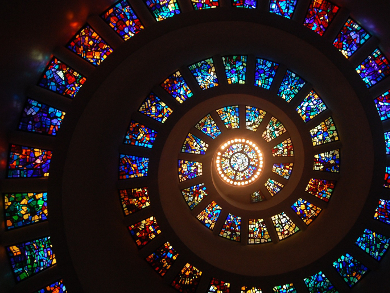Dichroic glass, whose color depends on the viewing angle, is used for optical filters and display panels. Modern production methods, which rely on nanostructured films, can be expensive and difficult to scale up. Dewetting, one promising method, involves heating an ultrathin metallic film until it disintegrates into discrete nanoparticles.
F. Javier García de Abajo, Valerio Pruneri, Barcelona Institute of Science and Technology, Spain, and colleagues dewetted silver films on silica to generate intense colors over a wide spectrum. The silver nanoparticles displayed a wide range of different colors for transmission and reflection. The colors varied with the particles’ base diameter and contact angle. This can be controlled by the duration and temperature of the heat treatment.
Increasing the contact angle shifts the reflectance colors toward shorter wavelengths, i.e., towards blue. Increasing the base diameter produces less intense colors. Exposing the nanoparticles to air shifts the colors toward shorter wavelengths. However, coating the particles with a polymer layer prevents oxidation of the silver and preserves the colors for several months. Adding a continuous ultrathin metal film over the polymer-coated nanoparticles produces additional structural colors through optical interference.
The researchers predict that applying their method to other metals could extend the spectral range still further, for instance, by using aluminum to produce UV wavelengths.
- Structural Coloring of Glass Using Dewetted Nanoparticles and Ultrathin Films of Metals,
Renwen Yu, Prantik Mazumder, Nick F. Borrelli, Albert Carrilero, Dhriti S. Ghosh, Rinu A. Maniyara, David Baker, F. Javier García de Abajo, Valerio Pruneri,
ACS Photonics 2016.
DOI: 10.1021/acsphotonics.6b00090
Also of Interest
- The Colors of Life,
Julien P. Renoult and Bernard Valeur,
ChemViews Mag. 2016.
DOI: 10.1002/chemv.201600025
The colors of the living world are produced by a wide variety of mechanisms




